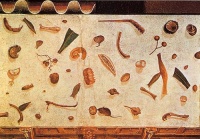Sosus of Pergamon
From The Art and Popular Culture Encyclopedia
| Revision as of 10:15, 27 August 2013 Jahsonic (Talk | contribs) ← Previous diff |
Current revision Jahsonic (Talk | contribs) |
||
| Line 1: | Line 1: | ||
| + | [[Image:The Unswept Floor.jpg|thumb|right|200px|Illustration: ''[[The Unswept Floor]]'' (detail)]] | ||
| {{Template}} | {{Template}} | ||
| - | [[Herakleitos]] makes [[The Unswept Floor]], mosaic variant of a 2nd-century BC painting by [[Sosos]] of [[Pergamon]]. It is now kept at [[Musei Vaticani]], [[Museo Gregoriano Profano]], [[ex Lateranese]], [[Rome]]. | + | '''Sosus of Pergamon''' was a Greek mosaic artist of the second century before Christ. He is the only mosaic artist whose name was recorded in literature. |
| - | The Hellenistic period is equally the time of development of the mosaic, particularly with the works of [[Sosos of Pergamon]], active in the 2nd century BC and the only mosaic artist cited by Pliny (XXXVI, 184). His taste for [[trompe l'oeil]] (optical illusion) and the effects of the medium are found in several works attributed to him such as the "[[Unswept Floor]]" in the Vatican museum, representing the leftovers of a repast (fish bones, bones, empty shells, etc.) and the "Dove Basin" at the [[Capitoline Museum]], known by means of a reproduction discovered in [[Hadrian's Villa]]. In it one sees four doves perched on the edge of a basin filled with water. One of them is watering herself while the others seem to be resting, which creates effects of reflections and shadow perfectly studied by the artist. | + | After the conquests of [[Alexander the Great]], the Greeks of major centers such as [[Pergamon]] and [[Alexandria]] displayed their wealth in decorations that included mosaics. [[Pliny the Elder]] names Sosus as the artist who created the "[[Unswept House]]" mosaic. This depicts the floor of a room covered with the remains of a feast, including fish, fruit and other fragments of food. |
| - | ==See also== | + | Pliny also says Sosus's mosaic work included an image of a dove drinking, and that the water reflected the shadow of the dove's head. |
| - | *[[Hellenistic art]] | + | |
| + | The image, meant to be mounted on a wall, was said to be so realistic that real doves flew into it while trying to reach their stone companions. | ||
| + | |||
| + | A mosaic from [[Hadrian's Villa]], now in the [[Capitoline Museums]], depicts a group of doves on a round bowl. | ||
| + | |||
| + | As described by Pliny, one dove is drinking while the others are sunning themselves. | ||
| + | |||
| + | ''The Doves of Pliny'', or the ''Capitoline Doves'' depicts the doves artistically but realistically. | ||
| + | |||
| + | The mosaic is made only of cubes of colored marble, without any colored glass as in other mosaics. | ||
| + | |||
| + | It was discovered in 1737 during excavations at Hadrian's Villa led by Cardinal [[Giuseppe Alessandro Furietti]], who thought it was the mosaic that Pliny had described, although other scholars think it is a copy of the original that was made for Hadrian. | ||
| + | |||
| + | The Hadrian's villa mosaic has in turn been copied many times in many formats. | ||
| {{GFDL}} | {{GFDL}} | ||
Current revision

|
Related e |
|
Featured: |
Sosus of Pergamon was a Greek mosaic artist of the second century before Christ. He is the only mosaic artist whose name was recorded in literature.
After the conquests of Alexander the Great, the Greeks of major centers such as Pergamon and Alexandria displayed their wealth in decorations that included mosaics. Pliny the Elder names Sosus as the artist who created the "Unswept House" mosaic. This depicts the floor of a room covered with the remains of a feast, including fish, fruit and other fragments of food.
Pliny also says Sosus's mosaic work included an image of a dove drinking, and that the water reflected the shadow of the dove's head.
The image, meant to be mounted on a wall, was said to be so realistic that real doves flew into it while trying to reach their stone companions.
A mosaic from Hadrian's Villa, now in the Capitoline Museums, depicts a group of doves on a round bowl.
As described by Pliny, one dove is drinking while the others are sunning themselves.
The Doves of Pliny, or the Capitoline Doves depicts the doves artistically but realistically.
The mosaic is made only of cubes of colored marble, without any colored glass as in other mosaics.
It was discovered in 1737 during excavations at Hadrian's Villa led by Cardinal Giuseppe Alessandro Furietti, who thought it was the mosaic that Pliny had described, although other scholars think it is a copy of the original that was made for Hadrian.
The Hadrian's villa mosaic has in turn been copied many times in many formats.

